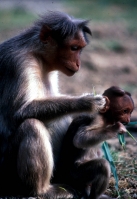


Downloadable versions of some my of recent papers are listed below (in reverse chronological order). For a complete publication list, see my CV.
Silk, J.B. & Strum, S.C. (2010) Maternal condition does not influence birth sex ratios in anubis baboons (Papio anubis). Public Library of Science One 5: 312750. (PDF)
Silk, J.B., Beehner, J.C., Berman, T.J., Crockford, C., Engh, A.L., Moscovice, L.R., Wittig, R.M., Seyfarth, R.M., & Cheney, D.L. 2010. Strong and consistent social bonds enhance the longevity of female baboons. Current Biology 20: 1359-1361.(PDF)
Silk, J.B., Beehner, J.C., Berman, T.J., Crockford, C., Engh, A.L., Moscovice, L.R., Wittig, R.M., Seyfarth, R.M., & Cheney, D.L. 2010. Female chacma baboons form strong, equitable, and enduring social bonds. Behavioral Ecology and Sociobiology 61: 197-204. (PDF)
Brosnan, S.F., Silk, J.B., Henrich, J., Mareno, M.C., Lambeth, S.P., Schapiro, S.J. 2009. Chimpanzees (Pan troglodytes) do not develop contingent reciprocity in an experimental task. Animal Cognition 12: 587-597. (PDF)
Cronin, K.A., Schroeder, K.K.E., Rothwell, E.S., Silk, J.B., Snowdon C.T. 2009. Cooperatively breeding cottontop tamarins (Saguinus oedipus) do not donate rewards to their long-term mates. Journal of Comparative Psychology 123: 231-241.(PDF)
Frank, R., Silk, J.B. 2009. Grooming exchange between mothers and non-mothers: the price of natal attraction in wild baboons (Papio anubis). Behaviour 136: 889-906.(PDF)
Frank, R., Silk, J.B. 2009. Impatient traders or contingent reciprocators? Evidence for the extended time course of grooming exchanges in baboons. Behaviour 136: 1123-1135.(PDF)
Silk, J.B., Beehner, J.C., Berman, T.J., Crockford, C., Engh, A.L., Moscovice, L.R., Wittig, R.M., Seyfarth, R.M., & Cheney, D.L. 2009. The benefits of social capital: close social bonds among female baboons enhance offspring survival. Proceedings of the Royal Society London, Series B. 276: 3099-3014. (PDF)
Silk, J.B. 2009. Nepotistic cooperation in nonhuman primate groups. Philosophical Transactions of the Royal Society 364: 3243-3254.(PDF)
Vonk, J., Brosnan, S.F., Silk, J.B., Henrich, J., Richardson, A.S., Lambeth, S.P., Schapiro, S.J., Povinelli, D.J. 2008. Chimpanzees do not take advantage of very low cost opportunities to deliver food to unrelated group members, Animal Behaviour 75:1757-1770.(PDF)
McNutt, J.W., Silk, J.B. 2008. Pup production, sex ratios, and survivorship in African wild dogs, Lycaon pictus. Behavioral Ecology and Sociobiology 62:1061-1067. (PDF)
Silk, J.B., Brown, G.R. 2008. Local resources competition and local resource enhancement shape primate birth sex ratios. Proceedings of the Royal Society London, Series B. 275: 1761-1765.(PDF)
Silk, J.B. 2007. The adaptive value of sociality in mammalian groups. Philosophical Transactions of the Royal Society 362: 539-559. (PDF)
Silk, J.B. 2007. The strategic dynamics of cooperation in primate groups. Advances in the Study of Behaviour 37:1-42. (PDF)
Duffy, K.G., Wrangham, R.W., Silk, J.B. 2007. Male chimpanzees exchange political upport for mating opportunities. Current Biology 21: R586-587. (PDF)
Silk, J.B. 2007. Social components of fitness in primate groups. Science 317:1347-1351. (PDF)
Silk, J.B., Brosnan, S.F., Vonk, J., Henrich, J., Povinelli, D.J., Richardson, A.F., Lambeth, S.P., Mascaro, J., Schapiro, S.J. 2005. Chimpanzees are indifferent to the welfare of other group members. Nature 435: 1357-1359. (PDF)
Silk, J.B., Willoughby, E., & Brown, G.R. 2005. Maternal rank and local resource competition do not predict birth sex ratios in wild baboons. Proceedings of the Royal Society London, Series B 272: 569-574.(PDF)
Silk, J.B. 2005. The evolution of cooperation in primate groups. In: Moral Sentiments and Material Interests: On the Foundations of Cooperation in Economic Life (H. Gintis, S. Bowles, R. Boyd, and E. Fehr eds.), MIT Press, Cambridge, pp. 43-73. (PDF)
Silk, J.B., Alberts, S.C., Altmann, J. 2004. Patterns of coalition formation by adult female baboons in Amboseli, Kenya. Animal Behaviour 67: 573-582. (PDF)
Cheney. D.L., Seyfarth, R.M., Fischer, J., Beehner, J., Bergman, T., Johnson, S.E., Kitchen, D.M., Palombit, R.A., Silk, J.B. 2004. Factors affecting reproduction and mortality among baboons in the Okavango Delta, Botswana. International Journal of Primatology 25:401-428.(PDF)
Manson, J.H., Navarette, C.D., Silk, J.B., Perry, S. 2004. Time-matched grooming in female primates? New analyses from two species. Animal Behaviour 67: 493-500.(PDF)Silk, J.B. 2003. Cooperation without counting: the puzzle of friendship. In: The Genetic and Cultural Evolution of Cooperation (P. Hammerstein, ed.), Dahlem Workshop Report 90. Cambridge, MA, The MIT Press, pp. 37-54.. (PDF)
Silk, J.B., Alberts, S.C., Altmann, J. 2003. Social bonds of female baboons enhance infant survival. Science 302:1231-1234. (PDF)
Buchan, J.C., Alberts, S.C., Silk, J.B., Altmann, J. 2003. True paternal care in a multi-male primate society. Nature 425:179-181. (PDF)
Silk, J.B. 2002. Practice random acts of aggression and senseless acts of intimidation: the logic of status contests in social groups. Evolutionary Anthropology 11:221-225. (PDF)
Brown, G.R., Silk, J.B.2002. Reconsidering the null hypothesis: Is maternal rank associated with birth sex ratios in primate groups? Proceedings of the National Academy of Sciences 99(17): 11252-11255. (PDF)
Silk, J.B. 2002. Using the ‘F’ word in primatology. Behaviour 139(2-3): 421-446. (PDF)
Silk, J.B. 2002. The form and function of reconciliation in primates. Annual Review of Anthropology 31: 21-44. (PDF)
Silk, J.B.2002. Kin selection in primate groups. International Journal of Primatology 23(4): 849–875. (PDF)
Silk, J.B. 2002. Grunts, girneys, and good intentions: the origins of strategic commitment in nonhuman primates. In: Commitment: Evolutionary Perspectives (ed. by R. Nesse), Russell Sage Press, pp. 138-157. (PDF)
Silk, J.B.2001. Bonnet macaques: evolutionary perspectives on females’ lives. In: Model Systems in Behavioral Ecology, (ed. by L.A. Dugatkin), Princeton University Press, Princeton, N.J., pp. 433-452. (PDF)
Silk, J.B. 2000. The function of peaceful post-conflict interactions: an alternate view. In: Natural Conflict Resolution (ed. by F. Aureli and F.B.M. de Waal), University of California Press, Berkeley, CA, pp 179-181. (PDF)
Silk, J.B., E. Kaldor, and R. Boyd. 2000. Cheap talk when interests conflict. Animal Behaviour 59: 423-432. (PDF)
Silk, J.B. and Stanford, C.B. 1999. Infanticide article disputed. Anthropology News 40: 27-29. (PDF)
Silk, J.B., D.L. Cheney, and R.M. Seyfarth. 1999. The structure of social relationships among female savannah baboons in Moremi Reserve, Botswana. Behaviour 136: 679-703. (PDF)
Silk, J.B. 1999. Male bonnet macaques use information about third party rank relationships to recruit allies. Animal Behaviour 58: 45-51. (PDF)
Silk, J.B. 1999. Why are infants so attractive to others? The form and function of infant handling in bonnet macaques. Animal Behaviour 57:1021-1032. (PDF)
Silk, J.B. 1996. Why do primates reconcile? Evolutionary Anthropology 5: 39-42.(PDF)
Silk, J.B., Cheney, D.L., & Seyfarth, R.M. 1996. The form and function of post-conflict interactions among female baboons. Animal Behaviour 52:259-268. (PDF)
